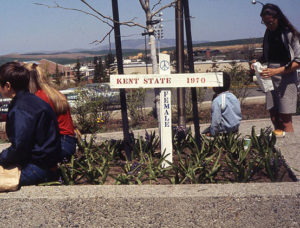By Nella Letizia, WSU Libraries
PULLMAN, Wash. – The familiar return of 20-somethings to Washington State University marks another start to an academic year. But a new historic exhibit on campus is a reminder that WSU during 1969-70 looked very different.
The unpopular Vietnam War was in its 14th year, racial tensions mounted after the assassination of Martin Luther King Jr., and WSU students, like those on college campuses nationwide, demanded change. They forged a legacy of activism that is still in place today.
The exhibit in Manuscripts, Archives and Special Collections, “Protest: Students, War + Racism, WSU 1969-70,” runs in the MASC main lobby at Terrell Library through December. An opening reception with refreshments is planned at 3 p.m. Thursday, Sept. 8. Exhibit hours are 8:30 a.m.-4:30 p.m. Monday-Friday except holidays.
A tradition of student protest
Inspiration for “Protest” came from a wall at the former WSU Koinonia House where students posted fliers in the 1970s, said Mark O’English, university archivist and exhibit curator. In 2015, the university demolished the building; but several sections of the wall were saved and are stored in Holland Library until a permanent home can be found.

“I think it’s worth looking at what students were passionate about,” O’English said. “Students took risks by protesting for something they thought was worth fighting for. You have to admire that. Without these types of protests, we wouldn’t have the space for students to voice their present-day concerns.”
Cougars have always been a force to be reckoned with since Washington State College’s first year of operation in 1892, when students protested the new college president’s arrival by throwing eggs and rotten cabbage (see the full story at https://news.wsu.edu/2016/03/10/march-22-celebrate-wsu-authors-crimson-reads/#more-146432).
On May 5, 1936, WSU students called a strike against the social regulations imposed by then dean of women Annie Fertig – who allegedly forbade women to wear red dresses on campus. Other regulations restricted hours for picnics, student organization meetings and house visits. Though Fertig printed a statement in the student newspaper refuting accusations made against her by the students, the damage was done.
“After the strike, she took a yearlong leave of absence and never came back,” O’English said.
Another May 5 protest
Protests at American universities erupted after President Richard Nixon’s announcement of the invasion of Cambodia on April 30, 1970. Four days later, the Ohio National Guard opened fire on student protesters at Kent State University, killing four people. In response, between 500 and 1,000 WSU students marched into the French Administration Building at 12:30 p.m. Tuesday, May 5, for a sit-in.

WSU President Glenn Terrell, in Washington, D.C., for a meeting, cut the trip short and returned to Pullman at 5:30 p.m. Students presented him with several demands: send a telegram to Nixon protesting the “illegal and immoral aggression of the United States Army into the neutral country of Cambodia” and the use of National Guard troops on university campuses; and that the university support the National Student Association’s sanctioned nationwide one-day strike in protest of the Cambodia invasion.
After four hours of negotiations, Terrell agreed to cancel Thursday classes so students, faculty and staff could attend a teach-in on U.S. military involvement in Cambodia. He also sent Nixon this telegram, accepted by the student protesters:
“The recent events on the campus of Kent State University and the extension of the war in Cambodia have created outrage and dismay on the part of a substantial segment of the campus at Washington State University. You have observed similar reaction across the nation. Many on our campus deplore the decision to send troops into Cambodia and the tragic deaths of the four students at Kent State.”
‘Third-world’ activism
Several weeks after the sit-in, representatives of WSU’s “third-world,” or minority, groups called for a campuswide strike after their demands were rejected by Terrell. From May 24 to June 1, students skipped classes, blocked roads and picketed buildings until the groups and Terrell reached agreement.
The results were: scheduling of fall 1970 and spring 1971 racism workshops put on by a committee of students and faculty representing all ethnicities; new classes and programs in minority studies; a focus on hiring minority faculty and staff and recruiting minority students; and a generally increased awareness of minority issues.
“When people think of Pullman in the ‘60s, they often forget the strike against racism, even misremembering it as a strike against the war like the ones taking place on other campuses,” said emeritus English professor Paul Brians, a faculty member who witnessed and participated in the events of those times.
“But to me it marked a moment when, despite the disarray of the movement’s national leadership and the increasing craziness and extremism of the left, a large number of students came together in an idealistic effort that eventually improved education at WSU in several ways.”
The legacy continues
O’English said WSU student protests of the past have laid the foundation for those of today, when campus student groups have rallied around or against multiple issues.

In 2010, students walked out of classes over rising tuition costs. Three years later, they protested the WSU Athletics’ giveaway of culturally insensitive Lucha Libre masks. In 2014, students stood with the national Black Lives Matter movement, followed by a #WakeUpWSU march over racial issues in 2015.
Last year, when the Pullman Planned Parenthood clinic reopened after it was burned to the ground, students protested on both sides of the abortion issue.
“Students raised the awareness of WSU and the community through their acts of protest,” O’English said. “While nothing this decade has even approached the size of the 1970 protests, student activism still remains a constant in modern life.”
Contacts:
Mark O’English, WSU Libraries’ archivist, 509-335-2739, markoe@wsu.edu
Nella Letizia, WSU Libraries’ public relations/communication coordinator, 509-335-6744, letizia@wsu.edu








